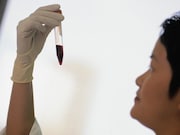Phlebotomy and hydroxyurea tied to improved survival, lower risk for thrombosis in older patients
TUESDAY, Nov. 27, 2018 (HealthDay News) — Among older patients with polycythemia vera (PV), therapeutic phlebotomy and hydroxyurea (HU) are associated with improved overall survival and decreased risk for thrombosis but are underused, according to a study recently published in Blood Advances.
Nikolai A. Podoltsev, M.D., Ph.D., from Yale University in New Haven, Connecticut, and colleagues conducted a retrospective cohort study in 820 older adults (median age, 77 years) diagnosed with PV from 2007 to 2013 using the linked Surveillance, Epidemiology, and End Results-Medicare database.
The researchers found that 16.3 percent of patients received neither phlebotomy nor HU, 23 percent were managed with phlebotomy only, 19.6 percent were managed with HU only, and 41.1 percent were managed with both treatments. During a median of 2.83 years of follow-up, 37.2 percent of patients died. Lower mortality was significantly associated with phlebotomy (yes/no; hazard ratio [HR], 0.65), increasing phlebotomy intensity (HR, 0.71), and a higher proportion of days covered by HU. There was a lower risk for thrombotic events associated with phlebotomy (yes/no; HR, 0.52) and increasing phlebotomy intensity (HR, 0.46). A higher proportion of days covered by HU was also associated with a significantly lower risk for thrombotic events.
“In this population-based study of older adults with PV reflecting contemporary clinical practice, phlebotomy and HU were associated with improved overall survival and decreased risk of thrombosis,” the authors write. “However, both treatment modalities were underused.”
Several authors disclosed financial ties to the pharmaceutical industry.
Copyright © 2018 HealthDay. All rights reserved.








